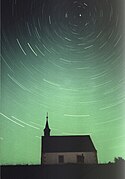International Space Station star trails - JSC2012E039800
Expedition 30 and Expedition 31 Flight Engineer Don Pettit provided information about photographic techniques used to achieve the images: "My star trail images are made by taking a time exposure of about 10 to 15 minutes. However, with modern digital cameras, 30 seconds is about the longest exposure possible, due to electronic detector noise effectively snowing out the image. To achieve the longer exposures I do what many amateur astronomers do. I take multiple 30-second exposures, then 'stack' them using imaging software, thus producing the longer exposure."
The image includes many natural and artificial lights that astronauts see while passing over the night side of Earth. On the ground, stationary features like cities appear as pale yellow-white streaks.
Looking toward the horizon, thunderstorms dot the landscape. Many of the compiled frames captured bright white lightning flashes. Above the horizon, a faint green-yellow phenomenon called airglow hugs the upper atmosphere. Look carefully at the large version of this image for at least one streak of light that is not aligned with all the others. That is a satellite. Additional info from this source.
The camera for these shots is "mounted on a bracket in the Cupola" [1].Relevantní obrázky
Relevantní články
Fotografie hvězdných drahFotografie hvězdných drah je specializovaný druh astrofotografie, který se zaměřuje na tvorbu snímků astronomických objektů na noční obloze. Hvězdy v důsledku otáčení Země a dlouhého expozičního času vytvářejí světelné dráhy. Tím jak se Země otáčí, nezůstávají hvězdy na svém místě, ale pomalu se posouvají více či méně k západu. Hvězdy se objeví a otáčejí se okolo severního i jižního pólu, z nichž pozorovatel vidí pouze jeden. Hvězdy ležící na obloze blízko severu se pohybují velmi pomalu, zatímco hvězdy blíže k rovníku „cestují“ poměrně rychle. Termín se používá pro podobné fotografie zachycené jinde, například na palubě Mezinárodní vesmírné stanice nebo na Marsu. .. pokračovat ve čtení














